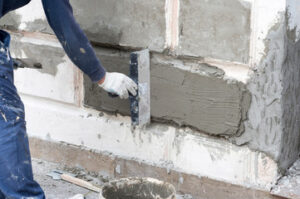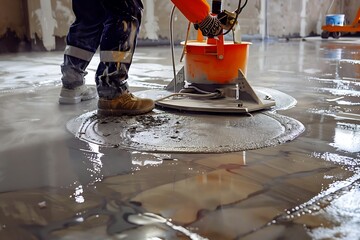The Importance of Concrete Repair
Repairing concrete surfaces is an essential part of maintaining safe and functional spaces. Taking care to properly repair and maintain damaged concrete can help extend its lifespan, reduce maintenance costs, and avoid potential damage to other structures or equipment.
Selecting the right products and ensuring proper application can make or break a concrete repair job. Using improper methods or skipping surface preparation can lead to poor adhesion and recurring problems. Contact Concrete Repair Bismarck for professional help.
Concrete is one of the most common and durable building materials, but even the toughest constructions face wear and tear over time. Whether due to age, weathering, or heavy foot and vehicle traffic, these structures may develop cracks and other forms of damage that necessitate concrete repair. Fortunately, these problems can be minimized with regular maintenance and the use of the right concrete repairing techniques.
Weathering is a complex process that affects both the physical structure of concrete and its surface appearance. While weathering often starts out as relatively minor changes, it can eventually lead to more intricate issues such as structural damage and water infiltration. One of the most common causes of weathering is temperature, which can cause the concrete to swell and shrink over time, resulting in surface cracks. These cracks can then become the gateway for water to enter the concrete matrix, causing further issues like spalling and discoloration.
Freeze-thaw cycles and chemical exposure are also major factors in the deterioration of concrete surfaces. The repeated freezing and thawing of concrete can result in cracks, while the use of de-icing salts can corrode reinforcing steel. This can lead to a number of problems, including scaling and efflorescence.
To mitigate these problems, the concrete should be properly maintained and sealed to prevent water infiltration. Sealants can also help to reduce stains and enhance the aesthetic of the concrete.
The most important factor in concrete repair is to address any damage as soon as it occurs. Failure to do so can lead to a larger problem and costly repairs down the road. It is important to carefully inspect the damaged area and select the right repairing technique.
There are several different repair methods for concrete, including epoxy injection and urethane sealing. Epoxy injection is an effective method for repairing cracks and stopping water flow, but it should only be used by licensed professionals. Urethane sealing does not form a structural bond, and it is not recommended for large-scale repairs. All repairs should be conducted by a professional, and the proper curing times must be observed to ensure the longevity of the repair.
Traffic
Municipal concrete structures like roads, sidewalks, and curbs are constantly subjected to the stress of traffic. This heavy use causes wear that eventually leads to cracks, potholes, and uneven surfaces. Other factors can also contribute to deterioration. For example, in colder regions, freeze-thaw cycles can exacerbate damage by seeping water into small cracks, which then expands and stresses the surface. This type of damage is known as spalling. Over time, these conditions can lead to costly and extensive repairs.
Uneven or sunken concrete poses safety hazards for pedestrians and vehicles. It can also cause structural issues if left unattended. That’s why municipalities need reliable, cost-effective repair solutions to maintain their aging infrastructure.
Traditional repair methods like mudjacking and polyjacking offer effective ways to raise and level damaged concrete. However, both require extensive excavation and lengthy disruptions to the public. This is why Mr. Level uses a non-invasive slabjacking technique that injects high-density polyurethane foam underneath concrete to fill voids, stabilize the soil, and lift sunken concrete. This method reduces costs, speeds up repair time, and keeps the public safe while minimizing impact to their day-to-day lives.
The most common signs of damage are cracks in the concrete’s surface or joints. These can be caused by the natural settling of the soil, which can shift or compress concrete slabs. It can also be a result of improper construction or installation, which puts excessive strain on the concrete. In addition, environmental factors like groundwater or clay content can cause concrete to erode more quickly.
Other common types of damage include spalling and scaling. Spalling is when small chips or flakes of the concrete surface begin to peel off. This is typically caused by freeze-thaw cycles, but can be exacerbated by exposure to deicing chemicals. Scaling is when the top layer of the concrete surface starts to peel off in patches or flakes. This is often due to insufficient curing during construction or frequent exposure to harsh chemicals.
Leaving these problems unattended can increase the risk of additional damage and more costly repairs in the future. Promptly addressing these minor problems helps to avoid more serious deterioration and extends the life of the concrete.
Sediment
Concrete structures are vulnerable to a wide range of environmental factors. These factors include water, freezing and thawing, mechanical loads, salts and other chemicals, and temperature changes. These factors cause the concrete to deteriorate and lead to cracks and other structural failures. Concrete repair is a process to fix these problems and prevent further damage to the structure. The type of repair method used will vary depending on the severity of the damage and what is causing it.
The factors causing the deterioration of concrete are complex, so repairing concrete requires addressing all of these factors to ensure that the structure is repaired correctly and will remain stable. A professional contractor can help you to identify the causes of deterioration and find an appropriate repair technique.
Cracks in concrete are the most common sign of a structural problem. They can be shallow and easy to repair, or they can be deep and extensive and require a significant amount of work. Regardless of the size and extent of the crack, it is important to repair it as soon as possible to avoid further damage.
Repairing concrete involves several different steps, including cleaning the damaged area, removing any loose debris and prepping the surface. It is also important to use a quality concrete repair product. This will help to ensure that the repairs are long lasting.
There are a number of products available to repair concrete, from a liquid cement that expands as it dries to a polyurethane sealant that will protect the cracks in your concrete. In addition, a bonding agent can be added to the concrete to improve its adhesion and durability.
Another way to repair cracked concrete is with a concrete epoxy injection. This is a durable and effective repair method for cracks in concrete surfaces, such as driveways or sidewalks. This method can be used in conjunction with prestressing steel, which adds a compressive force to the cracks and can further strengthen your concrete structure.
Surface treatments are a simple and cost-effective way to repair minor surface issues in concrete. These products are available in a variety of forms, from sprays to trowel-applied compounds. They can be applied to concrete floors, walls, and other surfaces. They can be used to address a wide variety of surface issues, such as efflorescence (white powdery deposits on the surface), spalling, crazing and small pock marks.
Age
Concrete may be a cornerstone of modern construction, but it still needs care and attention. It is vulnerable to environmental factors like freeze-thaw cycles, moisture and UV radiation. Addressing damage promptly can prevent it from getting worse and save time and money in the long run.
The first step in repairing concrete is recognizing it when it occurs. This is not always easy, as concrete deterioration comes in many forms. Typical aging includes fading, cracking and honeycombing. It can also occur from unnatural causes, such as chemical damage or impact.
To determine if concrete is in need of repair, it must be evaluated onsite. Visual inspection is the most common method, but it is only applicable to exposed and accessible surfaces. It can be supplemented by mechanical sounding to identify underlying concrete distress, such as delamination.
For successful repairs, the bond strength between the repair material and existing concrete is critical. This is why it is important to use the best materials possible for the job, and to follow proper mixing, placement and curing procedures. It is also important to consider the age of the concrete when making a repair, as older concrete has a lower tensile strength and higher porosity than newer concrete.
Achieving a high level of compressive strength in early age can be beneficial for the durability of repaired concrete, but it should not be prioritized over good adhesion. In fact, it is often a mistake to use high-strength, high-stiffness repair materials that are incompatible with existing concrete.
Once the repairs have been completed, it is essential to properly cure the concrete. This can be done by applying a liquid membrane-forming curing compound to the surface of the concrete and covering it with a plastic sheet. This will help to ensure that the repair materials adhere to the concrete and do not become loose over time.
A good concrete repair will not only look nice, but it will also last longer than an unrepaired surface. The key to extending the life of your concrete is to regularly evaluate it and address any damage as soon as it occurs. This will help to avoid larger problems down the road and reduce the need for costly replacement.

